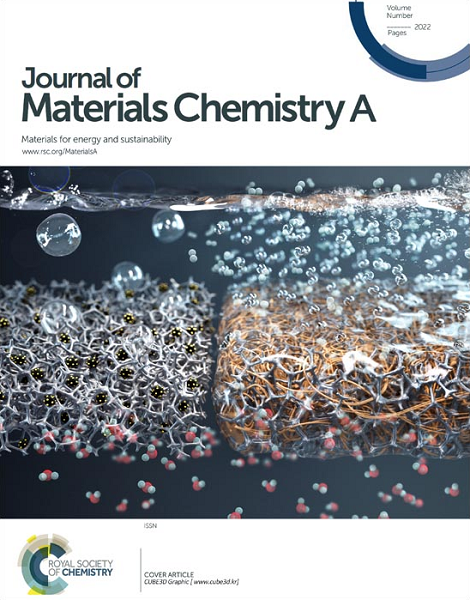Shielding effect in the synthesis of Gd-doped copper oxide catalysts with enhanced CO2 electroreduction to ethylene
IF 10.7
2区 材料科学
Q1 CHEMISTRY, PHYSICAL
引用次数: 0
Abstract
Electrocatalytic reduction reaction of carbon dioxide (CO2RR) into ethylene can achieve efficient conversion and utilization of CO2, which also provides a new and sustainable way to mitigate climate change. Copper based catalysts exhibit special activity for CO2RR to C2H4, but limited by the low selectivity and high overpotential. The controlled doping of rare-earth metal ions into copper catalyst is supposed to modulate the electron density of Cu active sites and thus to promote C-C coupling reaction and enhance the selectivity of C2H4. Herein, we report a Gd-doped copper oxide catalyst (Gd-CuO) synthesized by a typical solvothermal method, in which the content of Gd doping and chemical state of Cu can be regulated precisely through the shielding effect of solvents used. The shielding effect is assigned to the modification of cation-anion and cation-solvent interactions, which affects the crystallization of CuO and incorporation of Gd in the solvothermal process. Under optimal conditions, the Faraday efficiency of ethylene product can reach up to 58.6% at −1.2 V vs. RHE in an H-cell. When applied in a flow cell, the Faraday efficiency of ethylene can reach 52.4% with a current density of 397.8 mA cm−2 at the same applied voltage. In situ FTIR and DFT calculations demonstrated that the controlled doping Gd by means of shielding effect in synthesis facilitates the improvement of electron density of Cu active sites and promotes the C-C coupling and adsorption of *COCOH intermediates, thus enhancing the selectivity of ethylene. This work provides insights for design and development of rare earth doping Cu-based catalysts in the future.掺钆氧化铜催化剂合成过程中的屏蔽效应,可增强二氧化碳电还原成乙烯的能力
将二氧化碳(CO2RR)电催化还原反应转化为乙烯可实现二氧化碳的高效转化和利用,这也为减缓气候变化提供了一种新的可持续途径。铜基催化剂在 CO2RR 转化为 C2H4 的过程中表现出特殊的活性,但受到低选择性和高过电位的限制。在铜催化剂中可控掺杂稀土金属离子可调节铜活性位点的电子密度,从而促进 C-C 偶联反应并提高 C2H4 的选择性。在此,我们报告了一种掺杂钆的氧化铜催化剂(Gd-CuO),该催化剂采用典型的溶热法合成,其中掺杂钆的含量和铜的化学状态可通过所用溶剂的屏蔽效应进行精确调节。屏蔽效应是由于阳离子-阴离子和阳离子-溶剂之间的相互作用发生了改变,从而影响了溶热过程中氧化铜的结晶和钆的掺入。在最佳条件下,乙烯产物的法拉第效率可达 58.6%,在 H 型池中,当电压为 -1.2 V 对 RHE 时。当应用于流动池时,在相同的应用电压下,电流密度为 397.8 mA cm-2 时,乙烯的法拉第效率可达 52.4%。原位傅立叶变换红外光谱和 DFT 计算表明,在合成过程中通过屏蔽效应控制掺杂 Gd,有利于提高 Cu 活性位点的电子密度,促进 C-C 耦合和 *COCOH 中间产物的吸附,从而提高乙烯的选择性。这项工作为今后设计和开发稀土掺杂铜基催化剂提供了启示。
本文章由计算机程序翻译,如有差异,请以英文原文为准。
求助全文
约1分钟内获得全文
求助全文
来源期刊

Journal of Materials Chemistry A
CHEMISTRY, PHYSICAL-ENERGY & FUELS
CiteScore
19.50
自引率
5.00%
发文量
1892
审稿时长
1.5 months
期刊介绍:
The Journal of Materials Chemistry A, B & C covers a wide range of high-quality studies in the field of materials chemistry, with each section focusing on specific applications of the materials studied. Journal of Materials Chemistry A emphasizes applications in energy and sustainability, including topics such as artificial photosynthesis, batteries, and fuel cells. Journal of Materials Chemistry B focuses on applications in biology and medicine, while Journal of Materials Chemistry C covers applications in optical, magnetic, and electronic devices. Example topic areas within the scope of Journal of Materials Chemistry A include catalysis, green/sustainable materials, sensors, and water treatment, among others.
 求助内容:
求助内容: 应助结果提醒方式:
应助结果提醒方式:


